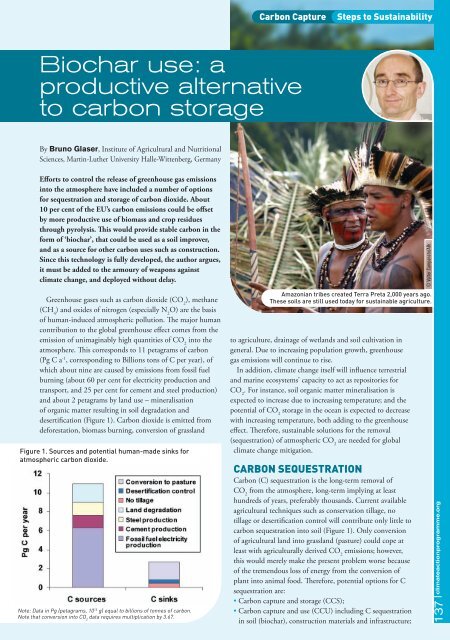Climate Action 2011-2012
You also want an ePaper? Increase the reach of your titles
YUMPU automatically turns print PDFs into web optimized ePapers that Google loves.
Carbon Capture<br />
steps to sustainability<br />
Biochar use: a<br />
productive alternative<br />
to carbon storage<br />
By Bruno Glaser, Institute of Agricultural and Nutritional<br />
Sciences, Martin-Luther University Halle-Wittenberg, Germany<br />
Efforts to control the release of greenhouse gas emissions<br />
into the atmosphere have included a number of options<br />
for sequestration and storage of carbon dioxide. About<br />
10 per cent of the EU’s carbon emissions could be offset<br />
by more productive use of biomass and crop residues<br />
through pyrolysis. This would provide stable carbon in the<br />
form of ‘biochar’, that could be used as a soil improver,<br />
and as a source for other carbon uses such as construction.<br />
Since this technology is fully developed, the author argues,<br />
it must be added to the armoury of weapons against<br />
climate change, and deployed without delay.<br />
© Valter Campanato/ABr.<br />
Greenhouse gases such as carbon dioxide (CO 2<br />
), methane<br />
(CH 4<br />
) and oxides of nitrogen (especially N 2<br />
O) are the basis<br />
of human-induced atmospheric pollution. The major human<br />
contribution to the global greenhouse effect comes from the<br />
emission of unimaginably high quantities of CO 2<br />
into the<br />
atmosphere. This corresponds to 11 petagrams of carbon<br />
(Pg C a -1 , corresponding to Billions tons of C per year), of<br />
which about nine are caused by emissions from fossil fuel<br />
burning (about 60 per cent for electricity production and<br />
transport, and 25 per cent for cement and steel production)<br />
and about 2 petagrams by land use – mineralisation<br />
of organic matter resulting in soil degradation and<br />
desertification (Figure 1). Carbon dioxide is emitted from<br />
deforestation, biomass burning, conversion of grassland<br />
Figure 1. Sources and potential human-made sinks for<br />
atmospheric carbon dioxide.<br />
Note: Data in Pg (petagrams, 10 15 g) equal to billions of tonnes of carbon.<br />
Note that conversion into CO 2<br />
data requires multiplication by 3.67.<br />
Amazonian tribes created Terra Preta 2,000 years ago.<br />
These soils are still used today for sustainable agriculture.<br />
to agriculture, drainage of wetlands and soil cultivation in<br />
general. Due to increasing population growth, greenhouse<br />
gas emissions will continue to rise.<br />
In addition, climate change itself will influence terrestrial<br />
and marine ecosystems’ capacity to act as repositories for<br />
CO 2<br />
. For instance, soil organic matter mineralisation is<br />
expected to increase due to increasing temperature; and the<br />
potential of CO 2<br />
storage in the ocean is expected to decrease<br />
with increasing temperature, both adding to the greenhouse<br />
effect. Therefore, sustainable solutions for the removal<br />
(sequestration) of atmospheric CO 2<br />
are needed for global<br />
climate change mitigation.<br />
Carbon sequestration<br />
Carbon (C) sequestration is the long-term removal of<br />
CO 2<br />
from the atmosphere, long-term implying at least<br />
hundreds of years, preferably thousands. Current available<br />
agricultural techniques such as conservation tillage, no<br />
tillage or desertification control will contribute only little to<br />
carbon sequestration into soil (Figure 1). Only conversion<br />
of agricultural land into grassland (pasture) could cope at<br />
least with agriculturally derived CO 2<br />
emissions; however,<br />
this would merely make the present problem worse because<br />
of the tremendous loss of energy from the conversion of<br />
plant into animal food. Therefore, potential options for C<br />
sequestration are:<br />
• Carbon capture and storage (CCS);<br />
• Carbon capture and use (CCU) including C sequestration<br />
in soil (biochar), construction materials and infrastructure;<br />
137 climateactionprogramme.org












